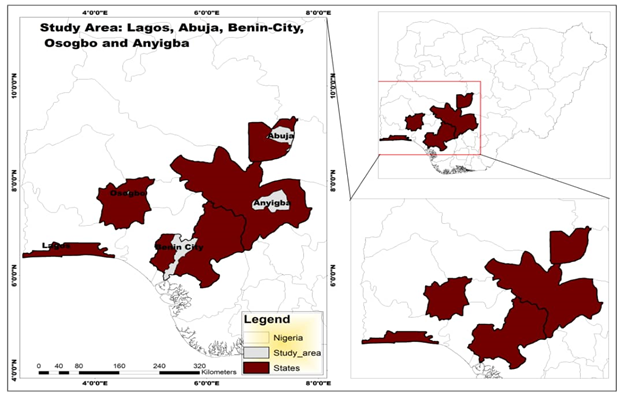Investigation of particulate matter Air Quality Index (AQI) and risk assessment in some locations in Nigeria
Keywords:
Particulate Matter (PM), Air Quality Index (AQI), Exposure assessment, Seasonal variation, Ambient air pollution, Spatial variationAbstract
Air pollution issues specifically with Particulate Matter (PM), have turned out to be a critical and pressing concern, posing grave threats to human health, the ecosystem and the environment which tragically resulted in millions of premature deaths worldwide. The study investigated the ambient air mass concentration of PM1, PM2.5 and PM10 in Lagos, Abuja, Osogbo, Anyigba and Benin City in Nigeria from 1st of May, 2021 to 30th of April, 2023. Air Quality Index (AQI) due to PM2.5 and PM10 were evaluated for all the locations with the rationale for establishing characterization for health impact and risk of exposure’s assessment. Hourly measurement of PM concentrations was collected from the Purple Air Real-Time Air Quality Sensors Network for all selected locations. The results revealed an increase in the daily average spatial variation of PM concentration across studied locations in order of Anyigba, Osogbo, Lagos, Abuja, and Benin City. The average daily AQI due to PM2.5 and PM10 for Lagos, Abuja, Anyigba, Osogbo, and Benin City are 98.07 and 36.95, 108.77and 43.22,47.66 and 14.35, 85.02 and 32.29 and 114.26 and 46.35 respectively. For the risk of exposure’s assessments, locations are at varying levels of risk of PM 2.5 exposure, Benin city was identified with the highest level of risk having some days with AQI ranging from unhealthy to very unhealthy even to Hazardous. PM10 air quality in all locations portends little or no risk of exposure to the public. Across all the studied locations, distinct seasonal difference was observed, characterized with higher monthly average AQI during the dry season compared to the rainy season

Published
How to Cite
Issue
Section
Copyright (c) 2024 O. F. Odubanjo, O. A. Falaiye, M. M. Orosun, M. Sanni

This work is licensed under a Creative Commons Attribution 4.0 International License.







